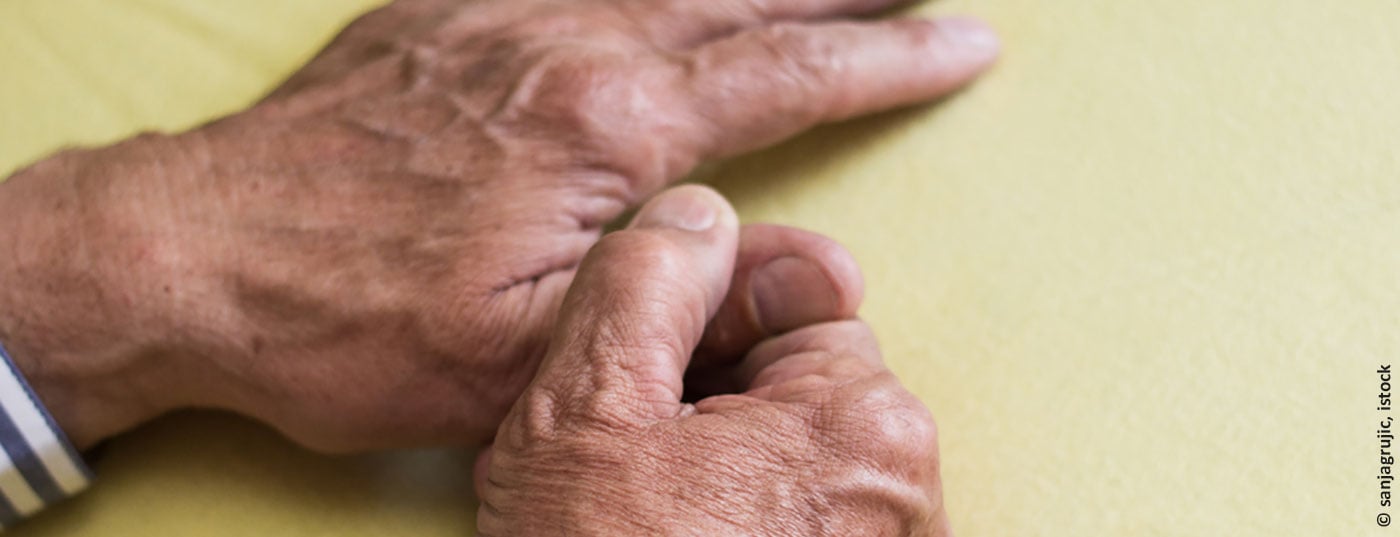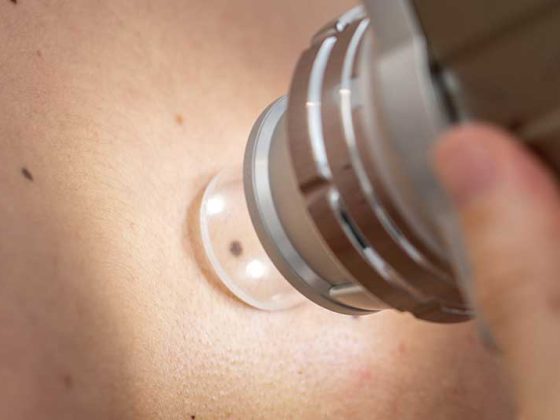Up to 30 percent of those affected by psoriasis vulgaris also have arthritis. The therapy of psoriatic arthritis depends on the type of manifestation. Various immunomodulating substances are available for this purpose, which are used in stages.
Psoriatic arthritis (PsA), by its progressive and destructive nature, can lead to significant limitations in function and quality of life. In 1964, PsA was recognized as a separate disease by the American Rheumatism Association.
20-30% of patients affected by psoriasis vulgaris also have arthritis. The incidence is approximately 3-8/100,000 [1]. Most often, PsA occurs during or after cutaneous involvement. However, it can also manifest before cutaneous psoriasis or even without psoriasis (sine psoriase). In this case, it is diagnosed on the basis of the infestation pattern and typical radiological changes. The severity of cutaneous psoriasis does not correlate with joint involvement.
Clinic
The picture of PsA is very heterogeneous and is classified by Moll and Wright [2] into five forms, varying from symmetric polyarthritis, asymmetric oligoarthritis affecting a few joints, to the rare mutilating arthritis. Isolated involvement of the distal interphalangeal joints (DIP), often accompanied by psoriatic involvement of the nails, or a ray involvement in which MCP, PIP, and DIP of individual fingers or toes are affected, is particularly typical and easily distinguished from rheumatoid arthritis, which should be considered for differential diagnosis. However, in cases of transverse involvement of the DIP joints, differentiation from finger polyarthrosis (Heberden’s arthrosis) can be difficult. In 20% of patients, an axial affection is detected, often a unilateral arthritis of a sacroiliac joint or a spondylitis (Fig. 1), which explains the assignment of PsA to the group of forms of spondyloarthritides. Other typical musculoskeletal disease manifestations in PsA include enthesitides (inflammation of tendon and ligament attachments) and dactylitides (sausage-like inflammation of individual fingers or toes). Extra-articular manifestations include uveitis and inflammatory bowel disease. More than half of patients with PsA are affected by at least one comorbidity, most commonly cardiovascular disease, metabolic syndrome, and depression and anxiety disorders. Systemic inflammation, mediated by inflammatory cells and cytokines including TNFα, leads to premature atherosclerosis via low-grade vascular inflammation. Other associated diseases include osteoporosis and hepatic steatosis [3].
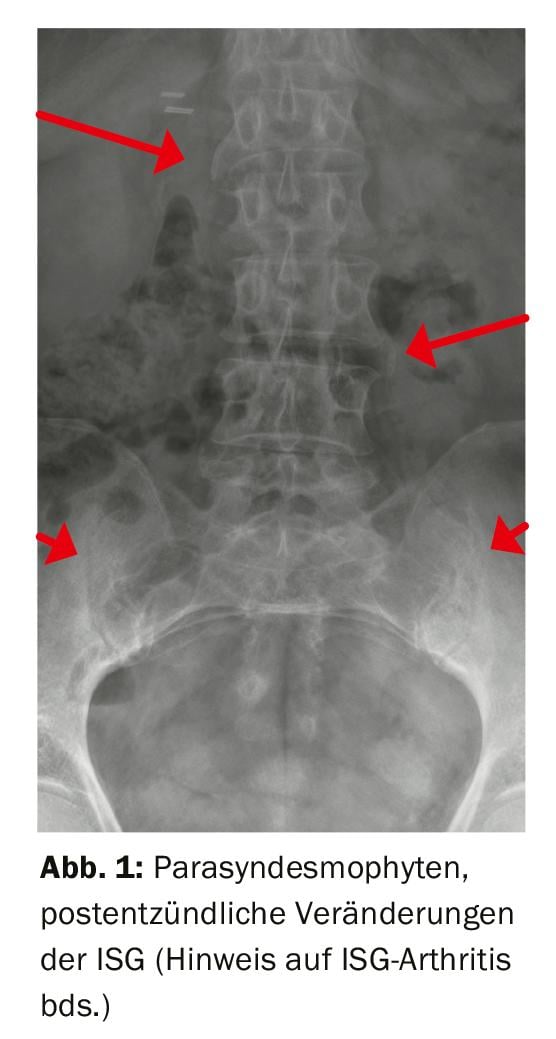
PsA is associated with complex genotypes, with a stronger genetic predisposition in PsA than in psoriasis vulgaris. Triggers of the disease can be environmental factors (esp. smoking), stress, obesity or trauma. The latter is known as the Köbner phenomenon in psoriasis vulgaris. According to one study, local trauma precedes the development of psoriatic arthritis in almost 25% of patients [4]. In the pathogenesis of psoriatic arthritis, the IL23/IL17 axis plays an important role in which type17 T helper cells produce proinflammatory cytokines via induction of IL23.
Diagnostics
Early diagnosis is important to ensure timely therapy to prevent sequelae and associated socioeconomic consequences. One of the strongest biomarkers for the development of PsA is prevalent psoriasis. Skin and nails should therefore be examined closely, not only at the typical predilection sites such as the extensor sides of affected joints: the hairline, auditory canals, belly button, buttock cleft, etc. should also be checked. As a special form, palmoplantar pustolosis is seen in particular in SAPHO syndrome, which is related to psoriatic arthritis. The CASPAR classification criteria (Tab. 1) [5] provide guidance in making a diagnosis.
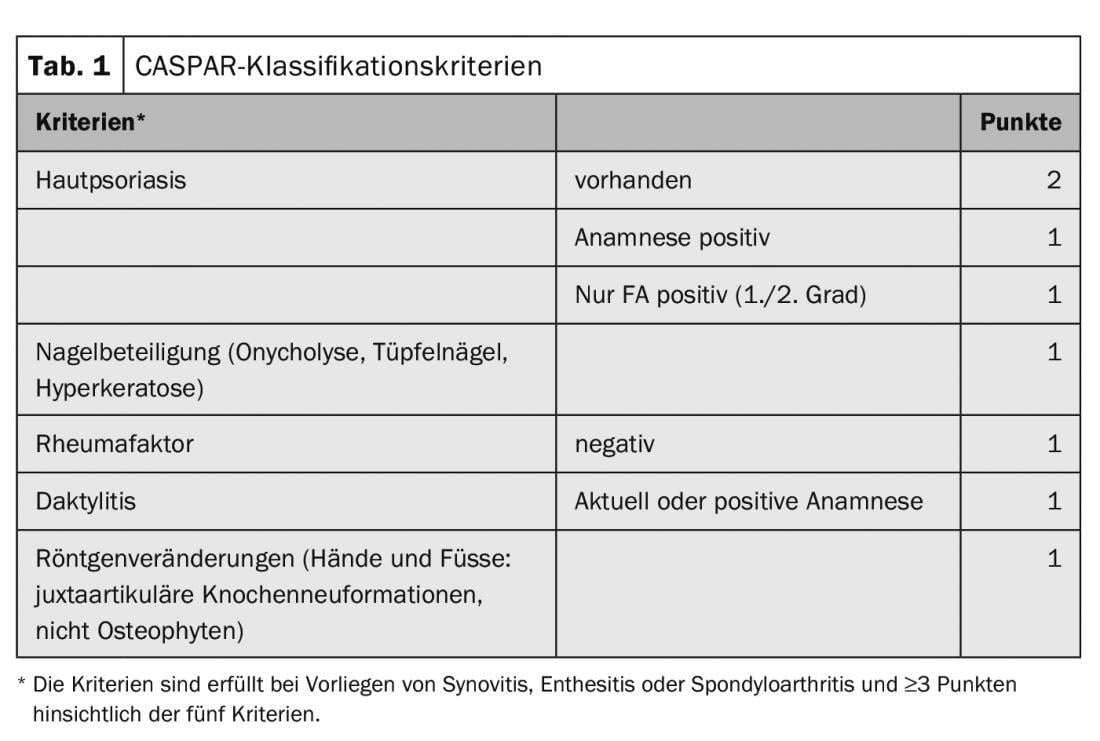
In imaging, the mixed picture of erosions and periosteal bone neoplasms is typical. In the mutilating form, changes up to acroosteolysis (bone dissolution of the finger or toe end links) or typical pencil-in-cup formations due to osteolysis sharpening the middle phalanx may occur (Fig. 2 and 3) . Conventional radiographs of the hands and feet as well as the spine and pelvis are recommended to determine the location with a question about destructions/osteoproliferations. Sonography and, alternatively, MRI of the axial skeleton are suitable for extended diagnostics, for example, to differentiate from rheumatoid arthritis, and to check disease activity. Negative rheumatoid factors are expected in the rheumatology laboratory, and CPP antibodies may be low-titer positive. A positive HLA-B27 gene trait is associated with axial involvement and uveitis.
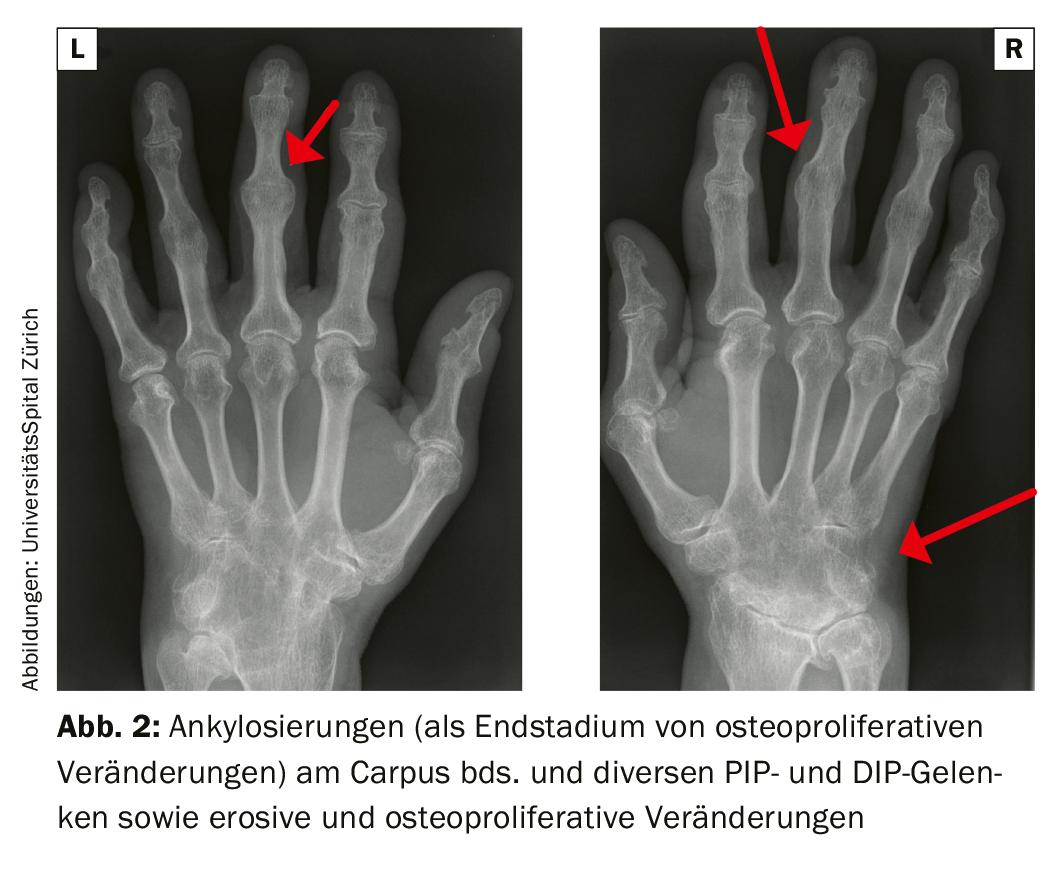
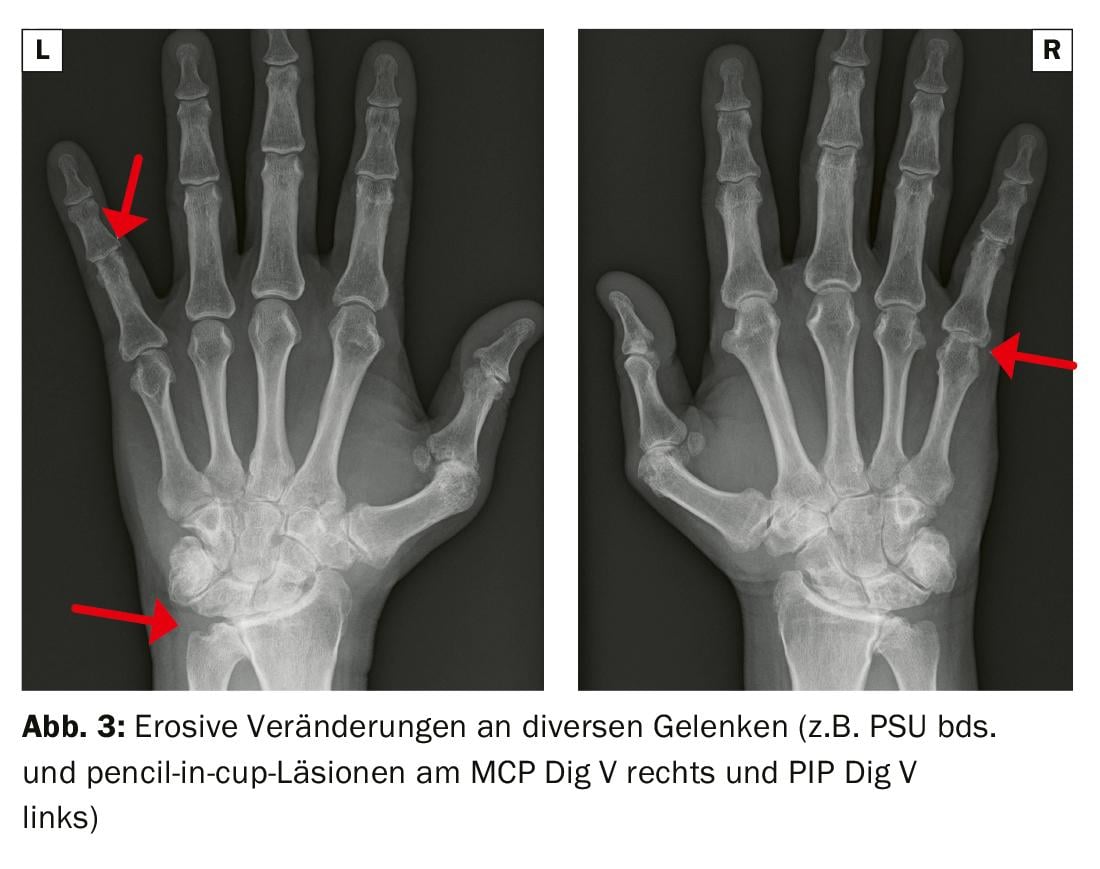
However, not all musculoskeletal complaints in psoriasis vulgaris per se can be attributed to psoriatic arthritis. Differential diagnoses include other spondyloarthritic diseases, rheumatoid arthritis, crystal arthritis, or degenerative diseases [6].
Therapy
The concepts of targeted therapy (“treat to target”) with tight control (“tight control”) that have been tested in rheumatoid arthritis have also been shown to be valid and effective in PsA to achieve remission or, if not possible, minimal disease activity (MDA). This is measured via the activity score, which is composed of various paramaters such as disease activity, inflammation levels and status. In clinical practice, the DAS 28 [7] and ASDAS [8] scores are particularly common. The earlier therapy can be started, the more likely remission will be achieved (“window of opportunity”).
Updated therapeutic guidelines are available from 2015 from the European League Against Rheumatism (EULAR) and the Group for Research and Assessment of Psoriasis and Psoriatic Arthritis (GRAPPA) [9]. The guidelines have been summarized for simplicity in Tables 2 and 3. Therapy is based on the manifestation type of PsA and is progressively expanded depending on the severity of the disease and response to prior immunomodulatory therapeutics. The recommendations of the two guidelines differ slightly, with EULAR primarily addressing rheumatologic aspects and GRAPPA addressing both rheumatologic and dermatologic aspects.
NSAIDs are prescribed in the initial stage for joint pain without swelling and axial involvement, and as adjunctive therapy when needed. Steroids are primarily used as adjunctive therapy injected locally and only very cautiously by oral route.
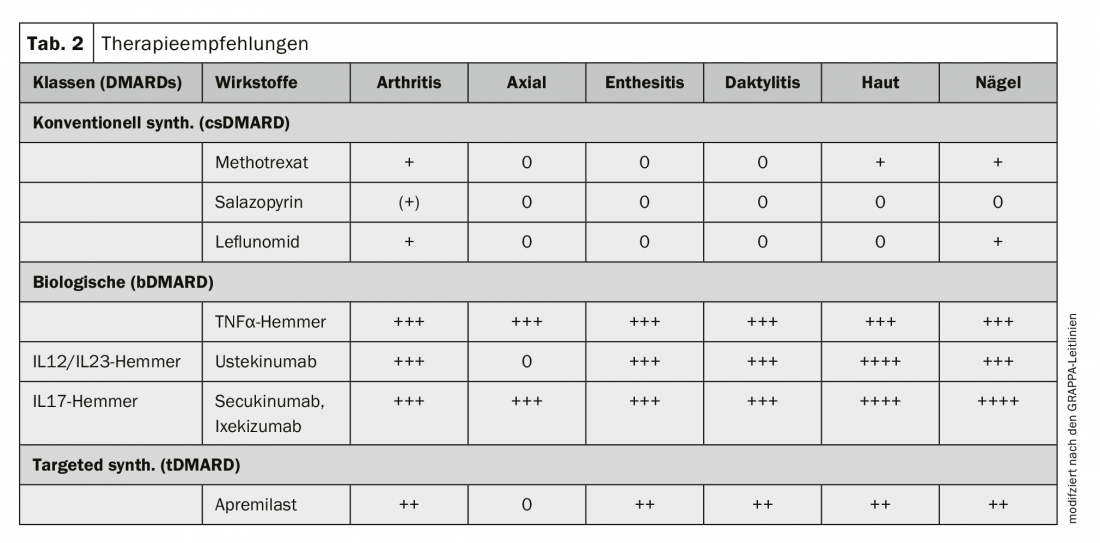
The disease-modifying antirheumatic drugs are divided into different groups. The oldest and least expensive preparations – so-called conventional synthetic disease-modifying substances – such as methotrexate (preferably subcutaneously), leflunomide (orally) or sulfasalazine (orally) are used first in synovitides, but are not effective in axial affections, enthesitides and dactylitides. Here, and in the case of failure of csDMARDs, primarily biological DMARDs, TNFα inhibitors (etanercept; adalimumab; golimumab; certolizumab pegol, all s.c.; infliximab, by infusion) or the new IL17 inhibitors (secukinumab; ixekizumab, both s.c.) and IL12/IL23 inhibitors (ustekinumab, s.c. or i.v.) are used. In case of lacking or insufficient effect or loss of effect, TNFα-blockers or substance classes are changed. The newer targeted synthetic DMARD apremilast, a tablet therapy, is effective in arthritis, enthesitides, and dactylitides, although less effective than biologics. Moreover, an effect on the infestation of the axial skeleton could not be shown.
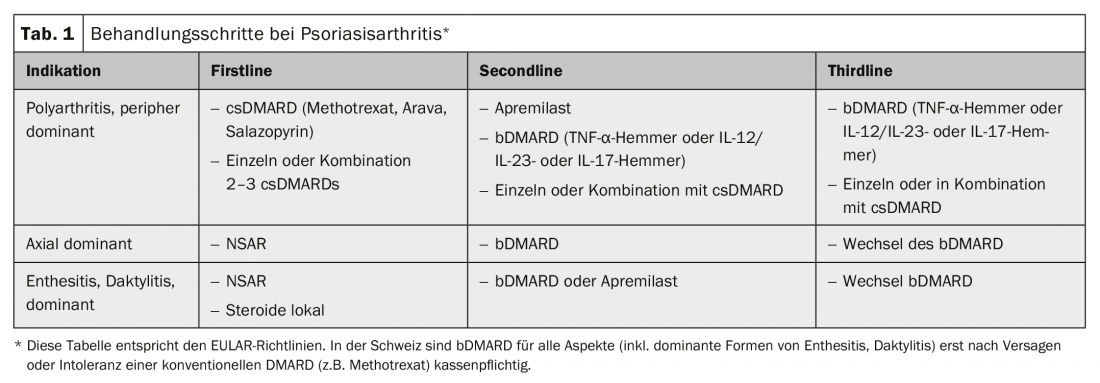
Any comorbidities are also taken into account in the choice of therapy. TNFα inhibitors, for example, are contraindicated in multiple sclerosis, and IL17A inhibitors can trigger Crohn’s disease relapses. Further information on therapies and the necessary preliminary clarifications and vaccinations recommended under immunosuppression can be found in the drug compendium or on the website of the Swiss Society of Rheumatology (as of 6.12.18). In development for the treatment of psoriatic arthritis are the IL23 inhibitor guselkumab, which is already approved in Switzerland for the treatment of psoriasis vulgaris, the IL17 receptor A inhibitor brodalumab and various Janus kinase inhibitors. Among other things, the indication expansion of tofacitinib, which is already used in rheumatology for the treatment of rheumatoid arthritis, is expected. Studies exist on bimekizumab, a dual inhibitor of IL17A and IL17F (bimekizumab), dual inhibitors of TNF-α and IL17A as well as completely novel compounds [10].
Take-Home Messages
- 20-30% of those affected by psoriasis vulgaris also have arthritis. The severity of skin involvement does not correlate with that of joint involvement.
- There are different manifestation types of psoriatic arthritis on both peripheral and axial skeleton. Extra-articular patterns of involvement also occur, e.g. uveitis.
- The therapy of psoriatic arthritis depends on the type of manifestation. Various immunomodulatory substances are available, which are used in a stepwise manner.
Literature:
- Stolwijk C, et. al: Epidemiology of spondyloarthritis. Rheum Dis Clin North Am 2012; 38(3): 441-476.
- Moll JM, Wright V: Psoriatic arthritis. Semin Arthritis Rheum 1973; 3(1): 55-78.
- Husni ME: Comorbidities in Psoriatic Arthritis. Rheum Dis Clin North Am 2015; 41(4): 677-698.
- Goupille P, Soutif D, Valat JP: Psoriatic arthritis precipitated by physical trauma. J Rheumatol 1991; 18(4): 633.
- Taylor W, et al: Classification criteria for psoriatic arthritis: development of new criteria from a large international study. Arthritis Rheum 2006; 54(8): 2665-2673.
- Van den Bosch F, Coates L: Clinical management of psoriatic arthritis. Lancet 2018; 391(10136): 2285-2294.
- Prevoo ML, et al: Modified disease activity scores that include twenty-eight-joint counts. Development and validation in a prospective longitudinal study of patients with rheumatoid arthritis. Arthritis Rheum 1995; 38(1): 44-48.
- van der Heijde D, et al: ASDAS, a highly discriminatory ASAS-endorsed disease activity score in patients with ankylosing spondylitis. Ann Rheum Dis 2009; 68(12): 1811-1818.
- Gossec L, et al: Management of psoriatic arthritis in 2016: a comparison of EULAR and GRAPPA recommendations. Nat Rev Rheumatol 2016; 12(12): 743-750.
- Elalouf O, Chandran V: Novel therapeutics in psoriatic arthritis. What is in the pipeline? Curr Rheumatol Rep 2018; 20(7): 36.
DERMATOLOGIE PRAXIS 2019; 29(5): 20-22

